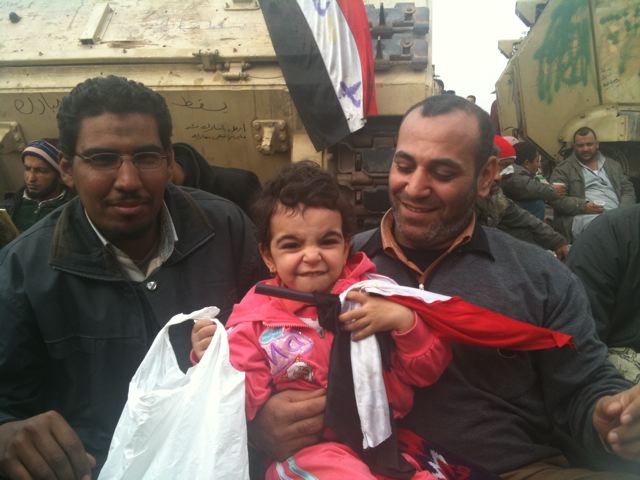Under the tanks
At the northern end of Tahrir Square, by the National Museum, groups of men sleep in shifts beneath the treads of the army tanks that mark the northern perimeter of Revolutionary Egypt. Demonstrators allowed the tanks so the army could protect the antiquities in the museum, and ever since the army has tried to move them further.
It’s a particularly tough – and diverse – group of men crammed in close quarters beneath the treads. I talked at length to a doctor from Cairo, a primary school teacher from rural Upper Egypt, and a microbus driver from Giza. They break class and religious barriers, and they have profoundly absorbed the ethos of a new Egypt.
Saif Eldeen, 29, a primary school English teacher, joined the protest on Thursday morning, traveling from his home in Sohag, Upper Egypt. He lied to his wife, telling her he had to file some government paperwork, and drove to Cairo. She wept when he called her from Tahrir Square. “She said, ‘You want to leave me and your three-month old baby to die?’ I told her, ‘God will provide.’”
Saif spoke with a gleam in his eye – common to many of the most dedicated protesters – and said he no longer had anything to lose, and therefore, no incentive to compromise: “If we lose, I will spend the rest of my life in prison, or I will be killed.”
He sported a pronounced prayer bump and a grimy dress shirt. He brought no change of clothes, and planned to stay until the government fell or wiped out the protesters.
Beside him sat the microbus driver from Giza with his three-year-old daughter in his lap. “I come when I can afford not to work,” said the driver, Gamal Moghawery ElShimi, 36. Like many of the dedicated protesters, he worried that the silent majority of Egyptians consider the protests a nuisance or worse. Most of his relatives found the entire protest distasteful, and discouraged him from attending. “They think I’ll end up in prison and it’s not worth it,” Gamal said. “I try to change their minds, but mostly they are unconvinced.”
He wiped his daughter’s nose with a kerchief. He said he brought her along despite the risk so that she would not grow up to live like her parents. “I want her to see and feel what it’s like to defy authority,” he said.
(In the bottom picture, Saif is seated on the left, and Gamal and his daughter on the right.)




Thank you Thanassis for riveting first hand report. It helps to bring the personal day to day experiences and spirit of protestors close to home. Hope the rest of the world is listening, especially at the governmental level. The thirst for freedom and human rights is as strong as the need for air, to stay alive.
Take care of yourself as well.
[…] a painfully astute observation. While Egyptian protesters are still camped underneath tank treads in Tahrir Square — having decided that it’s ride or die, in so many words — America still seems to […]